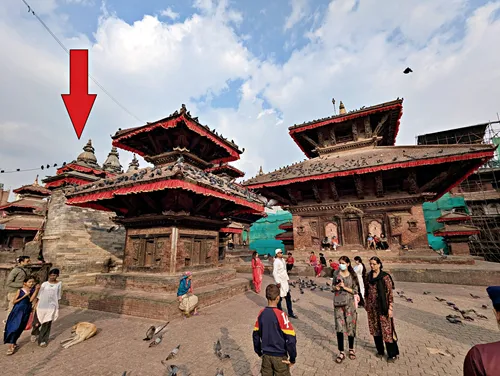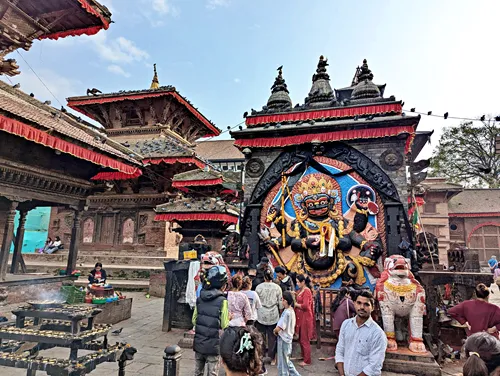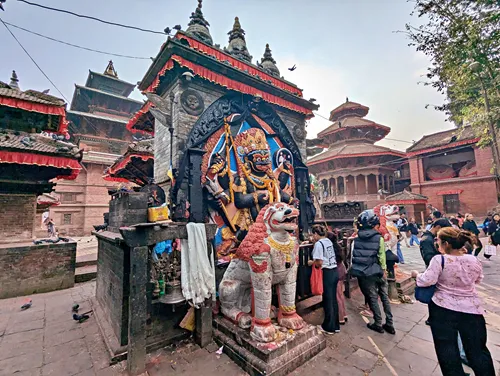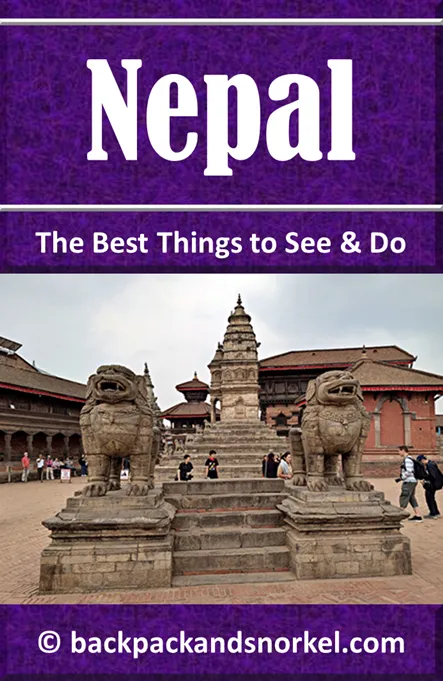Shree Kaal Bhairav Temple: Discovering Kathmandu Durbar Square's Fierce Guardian Deity - Nepal Purple Travel Guide
(map, reviews)
This is Premium Content! To access it, please download our
Backpack and Snorkel Purple Travel GuideWalk back to Indrapur Temple. Your next destination is Shree Kaal Bhairav Temple, which is located directly behind (north) of it.
Shree Kaal Bhairav Temple in Kathmandu Durbar Square is a captivating open-air shrine featuring a colossal stone image of Kaal Bhairav, the fierce form of Lord Shiva. Known for its historical role in dispensing divine justice, the temple remains a powerful symbol of truth and protection.



Here at Backpack and Snorkel Travel Guides, we typically promote self-guided walking tours.
But we realize that not everybody likes to walk by themselves in a foreign city. So, just in case that you rather go with ab guide: NO PROBLEM! Please see the Viator tours below.
free GuruWalk tours
paid Viator tours
Origin of the name Shree Kaal Bhairav Temple
The temple is named after Kaal Bhairav, a fierce and wrathful manifestation of Lord Shiva. In Sanskrit, ‘Kaal’ means time or death, and ‘Bhairav’ refers to a terrifying form. Together, the name Kaal Bhairav symbolizes the lord who controls time and annihilation, reinforcing his reputation as a powerful protector and enforcer of truth.
Historical Background of Shree Kaal Bhairav Temple
The massive stone sculpture of Kaal Bhairav with its eyes wide, fangs bared, and adorned with a crown of skulls, is believed to date back to the 17th century, when it was commissioned by King Pratap Malla, a notable patron of the arts and architecture during the Malla dynasty. The image is said to have been discovered in a nearby field and brought to Durbar Square, where it was enshrined in a small temple without walls, exposing the image to the elements and the awe of visitors.
Cultural and Religious Importance of Shree Kaal Bhairav Temple
For centuries, the Kaal Bhairav Temple has been used as a divine court of justice. In the past, individuals accused of crimes were brought before the fearsome image to testify, under the belief that lying in front of Kaal Bhairav would result in immediate divine punishment.
Today, devotees visit to offer flowers, oil lamps, and vermilion powder, especially on Bhairav-related festivals and important ritual days. The deity remains a powerful symbol of protection, truth, and cosmic time.
Architectural Features of Shree Kaal Bhairav Temple
Though there is no traditional temple structure enclosing the image, the site is marked by a low pedestal and a metal fence surrounding the 6-foot-tall (1.8 m) stone figure, richly decorated with gold-painted eyes, jewelry, and symbolic weapons.
Back to your self-guided tour
Author: Rudy at Backpack and Snorkel
Bio: Owner of Backpack and Snorkel Travel Guides. We create in-depth guides to help you plan unforgettable vacations around the world.
Other popular Purple Travel Guides you may be interested in:
Like this Backpack and Snorkel Purple Travel Guide? Pin these for later:





